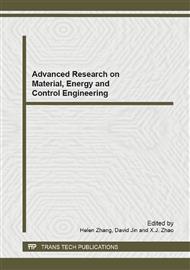[1]
Alfons J. M. Stams, Caroline M. Plugge, Electron transfer in syntrophic communities of anaerobic bacteria and archaea, Nature. 7 (2009) 568-577.
DOI: 10.1038/nrmicro2166
Google Scholar
[2]
Paul G. Falkowski, Tom Fenchel, Edward F. Delong, The microbial engines that drive Earth's biogeochemical cycles, Science. 280 (2008) 1034–1039.
DOI: 10.1126/science.1153213
Google Scholar
[3]
Alfons J. M. Stams, Frank A. M. de Bok, Caroline M. Plugge, Exocellular electron transfer in anaerobic microbial communities, Environmental Microbiology. 8 (2006) 371–382.
DOI: 10.1111/j.1462-2920.2006.00989.x
Google Scholar
[4]
J. H. Thiele, J. G. Zeikus, Control of interspecies electron flow during anaerobic digestion: significance of formate transfer versus hydrogen transfer during syntrophic methanogenesis in flocs, Appl. Environ. Microbiol. 54 (1988) 20–29.
DOI: 10.1128/aem.54.1.20-29.1988
Google Scholar
[5]
M. Carepo et al, Hydrogen metabolism in Desulfovibrio desulfuricans strain New Jersey (NCIMB 8313) — comparative study with D. vulgaris and D. gigas species, Anaerobe. 8 (2002) 325–332.
DOI: 10.1016/s1075-9964(03)00007-6
Google Scholar
[6]
G. Meshulam-Simon, S. Behrens, A. D. Choo, Hydrogen metabolism in Shewanella oneidensis MR-1, Appl. Environ. Microbiol. 73 (2007) 1153–1165.
DOI: 10.1128/aem.01588-06
Google Scholar
[7]
R. G. Sawers, Formate and its role in hydrogen production in Escherichia coli, Biochem. Soc. Trans. 33 (2005) 42–46.
Google Scholar
[8]
R. K. Thauer, K. Jungermann, K. Decker, Energy conservation in chemotrophic anaerobic bacteria, Bacteriol. Rev. 41 (1977) 100–180.
DOI: 10.1128/br.41.1.100-180.1977
Google Scholar
[9]
R. K. Thauer, A. K. Kaster, H. Seedorf, Methanogenic archaea: ecologically relevant differences in energy conservation, Nature Rev. Microbiol. 6 (2008) 579–591.
DOI: 10.1038/nrmicro1931
Google Scholar
[10]
B. Schink, R.K. Thauer, Microbiology and Technology, in: G. Lettinga, A. J. B. Zehnder (Eds. ), Granular Anaerobic Sludge, Pudoc-Publishing Inc., Wageningen, 1988, p.5–17.
Google Scholar
[11]
N. Müller, B. M. Griffin, U. Stingl, Dominant sugar utilizers in sediment of Lake Constance depend on syntrophic cooperation with methanogenic partner organisms, Environ. Microbiol. 10 (2008) 1501–1511.
DOI: 10.1111/j.1462-2920.2007.01565.x
Google Scholar
[12]
M. P. Bryant, E. A. Wolin, M. J. Wolin, Methanobacillus omelianskii, a symbiotic association of two species of bacteria, Arch. Mikrobiol. 59 (1967) 20–31.
DOI: 10.1007/bf00406313
Google Scholar
[13]
M. J. McInerney et al, The genome of Syntrophus aciditrophicus: life at the thermodynamic limit of microbial growth, Proc. Natl Acad. Sci. 104 (2007) 7600–7605.
DOI: 10.1073/pnas.0610456104
Google Scholar
[14]
T. Kosaka et al, The genome of Pelotomaculum thermopropionicum reveals niche-associated evolution in anaerobic microbiota, Genome Res. 18 (2008) 442–448.
DOI: 10.1101/gr.7136508
Google Scholar
[15]
A. J. M. Stams et al, Exocellular electron transfer in anaerobic microbial communities, Environ. Microbiol. 8 (2006) 371–382.
Google Scholar
[16]
M. Nakanishi-Matsui, M. Futai, Stochastic rotational catalysis of proton pumping F-ATPase, Philos. Trans. R. Soc. Lond. B Biol. Sci. 363 (2008) 2135–2142.
DOI: 10.1098/rstb.2008.2266
Google Scholar
[17]
J.C. Scholten et al, Evolution of the syntrophic interaction between Desulfovibrio vulgaris and Methanosarcina barkeri: involvement of an ancient horizontal gene transfer, Biochem. Biophys. Res. Commun. 352 (2007) 48–54.
DOI: 10.1016/j.bbrc.2006.10.164
Google Scholar
[18]
R. Cord-Ruwisch, B. Ollivier, Interspecific hydrogen transfer during methanol degradation by Sporomusa acidovorans and hydrogenophilic anaerobes, Arch. Microbiol. 144 (1986) 163–165.
DOI: 10.1007/bf00414728
Google Scholar
[19]
D.L. Valentine, D.C. Blanton, W.S. Reeburgh, Hydrogen production by methanogens under lowhydrogen conditions, Arch. Microbiol. 174 (2000) 415–421.
DOI: 10.1007/s002030000224
Google Scholar


